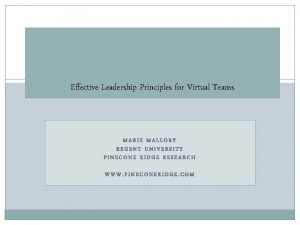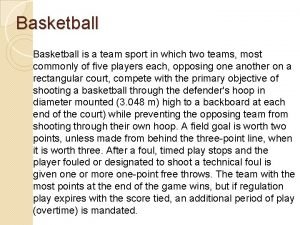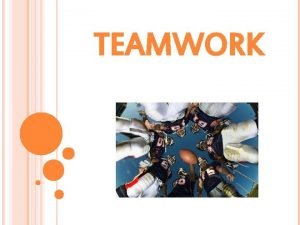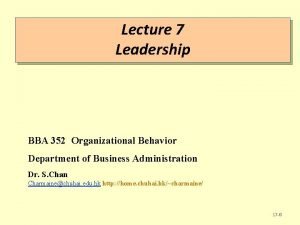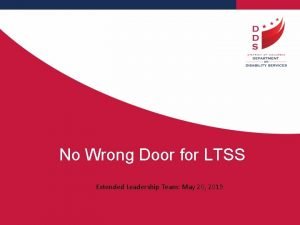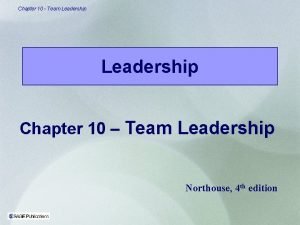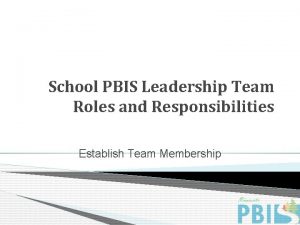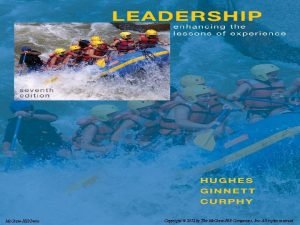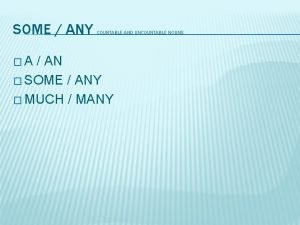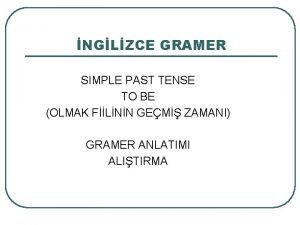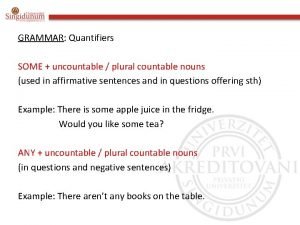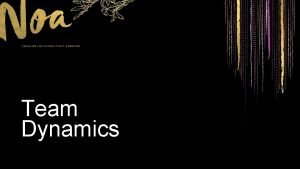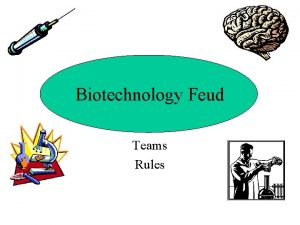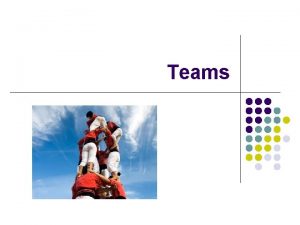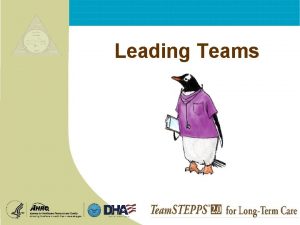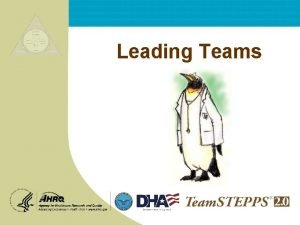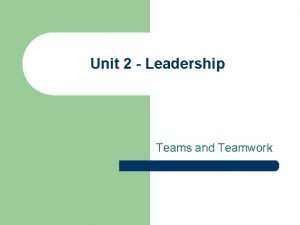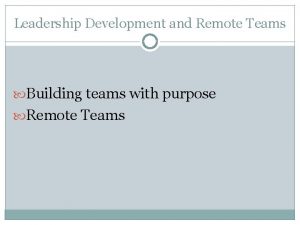Teams Team Leadership Team Dynamics There is no






























- Slides: 30

Teams Team Leadership

Team Dynamics ● ● “There is no I in TEAM. ” ➢ But there is an M and an E ➢ Team Leadership: getting ME to WE But first. . .

Talent vs. Teams ● ● ● On the one hand, we possess the technical competence, physical resources, and intellectual capacity to satisfy all the basic needs of Mankind. On the other hand, we seem to lack the essential ability to work together effectively to solve critical problems. Larson and La. Fasto (1989)

Six Phases of a Project 1. Enthusiasm 2. Disillusionment 3. Panic 4. Search for the Guilty 5. Punishment of the Innocent 6. Praise and Honours for the Non-Participants



Teamwork ● ● ● Teamwork is a lot of people doing what I say. Without teamwork, there is no one else to blame. Teamwork: united in a common goal to keep my job.

Teamwork ● “Never doubt that a small group of thoughtful, committed people can change the world. Indeed, it is the only thing that ever has. ” - Margaret Meade, Anthropologist • Widely attributed to Meade, no one knows for sure.

Tuckman's Stages model end start Adjourning Forming Performing Storming Norming (Tuckman, 1965 and Jensen & Tuckman, 1977)

Tuckman's Stages model Forming ● ● Groups assembled by availability, expertise, cost. Rarely by social needs. Individuals are trying to get to know each other and the organization. What are the dependencies. . . Between people? Between tasks? Leaders provide direction and outline expectations.

Tuckman's Stages model Forming ● Roles are assigned initially by task ● Behaviour is individually centered ● ● Members internally focused on negotiating boundaries of ➢ Interpersonal behaviour ➢ Task activity Join? Commit to group and/or task?

Tuckman's Stages model Forming Governing values ● ● Win: give & get social acceptance Maintain Control: busy with structure, organization, who does what and when Avoid Embarrassment: avoid controversy or conflict Rational: Serious issues and feelings are not discussed

Tuckman's Stages model Storming ● ● Comfortable enough to confront each other's ideas and perspectives What are the real tasks that need doing? How to function independently and together? What leadership model to accept?

Tuckman's Stages model Storming ● ● ● Competition for status and acceptance of ideas Emphasis on autonomy and individual rights Currency of negotiation/power: tasks Leader coaches members on how to manage conflict and focus on goals Active Listening

Tuckman's Stages model Norming ● Standards of behaviour and task accomplishment emerge ● Opinions respected. Differences valued. ● Transition from internal to group needs ● From competition to cooperation. ● Leader serves more as facilitator than director. Decision making devolves.

Tuckman's Stages model Norming ● ● Establish team rules for ➢ Working together ➢ Sharing information ➢ Resolving conflict ➢ Processes used to get the job done Members develop self-direction

Tuckman's Stages model Performing ● ● Team members know, trust and rely on each other; share goals. Interpersonal structure supports task performance ● Roles are flexible and functional ● Expected & accepted high standards ● Member differences are utilized

Tuckman's Stages model Performing ● ● Problem resolution about tasks and goals not interpersonal relationships Team leader has new role working ➢ ➢ Within the group accomplishing tasks instead of resolving interpersonal issues To solve problems external to the group

Tuckman's Stages model Adjourning ● 5 th stage added in 1977. ● Member(s) leave group. ● ● Concern for personal well-being of team and members, not tasks or goals. Usually leader driven to make time for ➢ Lessons learned ➢ Celebrate success

Group exercise ● Cross the pond ➢ ● Debrief Build a structure ➢ debrief

High Performing Teams ● ● ● Recognized by others as a “group” Perform tasks affecting others outside the group Have common goals and share a purpose Which are tied to each individual’s roles and responsibilities Committed to the work and to each other

High Performing Teams ● ● Goals are challenging for both team and individual members Challenges facilitate inter-dependent behavior: “None of Us is as Good as All of Us”. – Ray Kroc, founder of Mc. Donald's ● High performing members supported. ● Low performing members relocated.

High Performing Teams ● ● Members have ➢ Talents needed by the team ➢ Desire to contribute ➢ Ability to be collaborative Each member has balanced skills. . . ➢ technical ➢ problem-solving ➢ decision-making ➢ interpersonal

High Performing Teams Incentives, motivation, and efficacy ● ● Extrinsic rewards ➢ Money (they can't pay you enough to like it) ➢ Public recognition (e. g. awards) Intrinsic rewards ➢ Tasks enjoyable in and of themselves ➢ “Work is its own reward. ” ➢ Sense of accomplishment, self-efficacy.

High Performing Teams High performing teams experience conflict ● ➢ Higher task conflict at project mid-point ➢ Higher relationship conflict close to deadlines Successfully form, storm, and norm

High Performing Leaders ● ● ● believe in their purpose and their people manage the principles, and the principles manage the team focus on purpose, goals, relationships committed to results that benefit the organization as well as each individual 8 Habits Of Highly Effective Google Managers

High Performing Leaders ● ● ● ● Coach more than direct Openly communicate: have no secrets Generate high team expectations Allow team members to set their own goals and control their work Stay out of the way of team members problems Display trust in members' abilities Hold teams responsible

Teamwork benefits ● increased organizational performance ● increase in team member satisfaction ● members become more valuable ● ● availability of new ideas, talent, and viewpoints. group decision making promotes more understanding, acceptance, and a clearer perspective of why something is taking place

References ● ● Tuckman, Bruce W. (1965) 'Developmental sequence in small groups', Psychological Bulletin, 63(6), 384 -399. Tuckman, Bruce W. , & Jensen, Mary Ann C. (1977). 'Stages of small group development revisited', Group and Organizational Studies, 2, 419 - 427.

References ● ● Bonebright, Denise A. (2010) '40 years of storming: a historical review of Tuckman's model of small group development. ', Human Resource Development International. Feb. 2010, Vol. 13 Issue 1, 111 -120. Bruce Jackson and Susan R. Madsen (2005) "Common Factors of High Performance Teams" Journal of Contemporary Issues in Business and Government 11. 2 (2005): 35 -49.
 Principles of effective leadership in virtual teams
Principles of effective leadership in virtual teams Basketball is a team sport in which two teams
Basketball is a team sport in which two teams Team's or teams'
Team's or teams' Bba in leadership and organizational dynamics
Bba in leadership and organizational dynamics Team dynamics questionnaire higher pe
Team dynamics questionnaire higher pe Team dynamics france
Team dynamics france Transactional leadership and transformational leadership
Transactional leadership and transformational leadership What is adaptive leadership style
What is adaptive leadership style Adaptive leadership vs situational leadership
Adaptive leadership vs situational leadership Extended leadership team
Extended leadership team Acq 1010 fundamentals of systems acquisition management
Acq 1010 fundamentals of systems acquisition management Hill model for team leadership
Hill model for team leadership Pbis leadership team roles and responsibilities
Pbis leadership team roles and responsibilities Ginnetts team leadership model
Ginnetts team leadership model Pbis leadership team
Pbis leadership team There is there are ejemplos
There is there are ejemplos There is there are part of speech
There is there are part of speech There is there are negative form
There is there are negative form There is ve there are
There is ve there are No, there aren’t.
No, there aren’t. There is there are
There is there are Mathematics is john's favorite subject
Mathematics is john's favorite subject Adjetivos demonstrativos
Adjetivos demonstrativos Some, any, much, many
Some, any, much, many Sustantivos en ingles contables
Sustantivos en ingles contables Pep unit
Pep unit Ingilizce gramer zamanlar tablosu
Ingilizce gramer zamanlar tablosu Exercising game
Exercising game There is there are
There is there are Arehay
Arehay There's and there are
There's and there are
